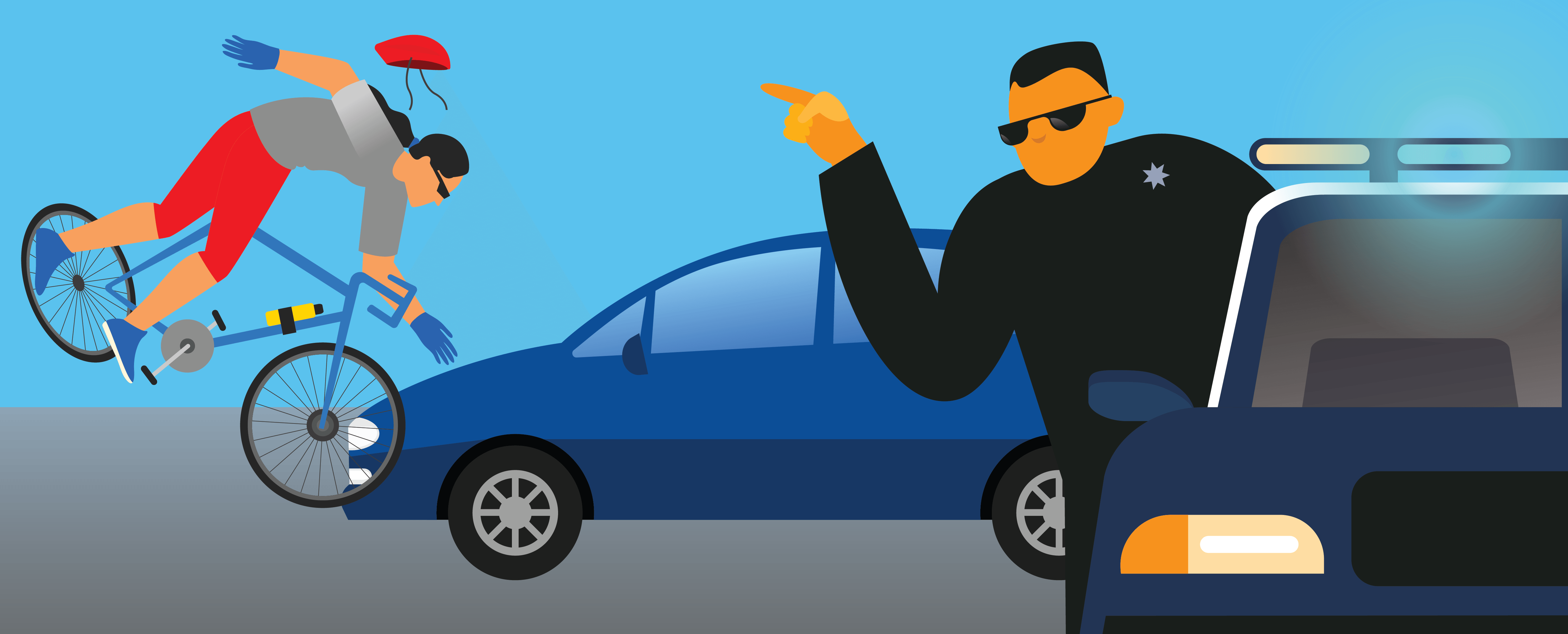In California, bicyclists have the same rights and responsibilities as car drivers, meaning they can be cited for speeding, running a red light, and other traffic offenses. Plus, since they have no physical protection in a crash, even small mistakes can be fatal.
Before you hit the road, make sure you know what you should (and shouldn’t) do. Here’s a closer look at the rules cyclists must follow in California, plus what’s new for 2025.
California Bicycle Laws: What’s New in 2025
The number of cyclist deaths in the U.S. increased from 1,117 in 2022 to 1,166 in 2024, prompting several states to tighten the laws governing bicycle use. Although cyclist fatalities have actually been decreasing in California, many of the new laws center around what is seen as an emerging risk for bike accidents: e-bike use. Let’s take a look.
- Changes in the definition of an e-bike: Passed in 2024, Senate Bill No. 1271 clarified what counts as an electric bicycle in California. To qualify, a bike must have working pedals and a motor of 750 watts or less. Bikes that don’t meet these requirements are no longer treated as e-bikes. They may instead be classified as mopeds or motorcycles, which carry additional requirements.
| E-bike Class | Pedals Required | Throttle Allowed | Max Motor Power | Motor Speed Limit | Additional |
|---|---|---|---|---|---|
| Class 1 | ✅ Yes | ❌ No | ≤ 750W | 20 mph (pedal-assist only) | Motor only helps while pedaling. |
| Class 2 | ✅ Yes | ✅ Yes | ≤ 750W | 20 mph (motor power) | Can run on throttle alone but cuts off at 20 mph. |
| Class 3 | ✅ Yes | ❌ No | ≤ 750W | 28 mph (pedal-assist only) | Must have a speedometer. No throttle allowed. |
- Age restrictions for e-bike riders: Under Assembly Bill 2234, anyone can ride a Class 1 e-bike, regardless of age. Class 2 e-bikes, which include throttle-assisted models, are limited to riders aged 12 and older. Class 3 electric bicycles, which can reach higher speeds, are restricted to riders over 16.
The law also allows local authorities to enforce stricter rules. For instance, San Diego County officials may prohibit children under 12 from using Class 1 and Class 2 e-bikes. - Restrictions on modifying e-bikes: Per AB 1774, an e-bike cannot be modified to exceed speed limits or power thresholds unless it still meets the legal definition of an e-bike following modification.
- Sharrows banned on high-speed roads: Per Senate Bill 1216, shared lane markings, or “sharrows,” are no longer permitted on streets with speed limits above 30 mph, unless used at intersections to connect designated bikeways. This rule applies to all sharrows, regardless of color or backing.
Traffic school can help you keep a clean driving record, prevent insurance increases, and more!
Key California Bike Riding Laws

California’s bicycle laws are meant to improve road safety and prevent fatalities. Below are the key regulations every cyclist should know – plus practical tips to stay compliant.
Where You’re Allowed to Ride Your Bike (Bike Lane Laws)

In California, you can ride your bike on most roads as long as you keep up with the traffic. That said, here are five rules to keep in mind for your safety and the safety of others:
- Stay to the right side of the road (CVC 21202): Ride as far to the right as possible so cars and other faster-moving vehicles can pass safely. However, there are exceptions to this rule:
- Passing: Generally, moving to the left side of the road is OK when overtaking other vehicles.
- Preparing for a left turn: Move toward the center of your lane before making a left turn.
- Avoiding hazards: Ride your bike toward the center or left side of the road if there are obstacles (e.g., construction work) on the right side.
- Riding on narrow roads: If the road is too narrow to share with other vehicles safely, you might need to move toward the center.
- When preparing for a right turn: If you’re approaching an area where a right turn is allowed, you can ride toward the left of the lane to prepare for the turn.
- Ride with the flow of traffic: Always ride with the traffic flow, not against it. In 2023, wrong-way riding contributed to 11.6% (135) of all cyclist deaths in the U.S., per the National Highway Traffic Safety Administration (NHTSA).
- Yield to pedestrians: Slow down ahead of time to allow pedestrians to cross safely. If someone has already stepped onto the crosswalk, stop and let them pass. Note that you must also yield to pedestrians when biking on a sidewalk.
- Use bike lanes whenever possible: Generally, riders must use designated bike lanes when available. If a bike lane has debris, is occupied by a parked car, or is otherwise unsafe to use, you may merge into the regular traffic lane until you can safely return to the bike lane.
- Bicycles aren’t allowed on freeways (mostly): According to CVC 21960, local authorities may forbid cyclists from riding on freeways and expressways. If access is allowed, then you should see a sign that says so. More often than not, bike riders cannot use these roads because they are designed for higher-speed motorized traffic. The same applies to toll bridges, per CVC 23330.
- Bicycles are allowed on the sidewalk (sometimes): Sidewalk riding is legal in California, but local authorities may prohibit it. For example, San Francisco allows it only for cyclists under 13 years old. But if you live in Sacramento, you can ride on the sidewalk in designated areas.
Signalling and Obeying Traffic Laws
Cyclists must obey California road signs, yield the right-of-way, and signal their turns, just like drivers are required to do. When a bike-specific signal is present, cyclists must obey that instead.
One key difference when riding a bike is that you’ll use hand signals to let others know what you plan to do next.

Bicycle Equipment
According to California law, bikes must also be equipped in specific ways.
According to CVC 21201 bikes riding at night must have:
- A front white light visible from 300 feet.
- A rear red reflector or light visible from 500 feet.
- White/yellow reflectors on pedals, shoes, or ankles.
- Reflectors on wheels or tires.
Bikes should also be equipped with a brake that’s strong enough to make a wheel skid on flat, dry pavement.
Bicycle bells and horns are allowed but not required.

Proper Riding Behavior for California Cyclists
When riding a bike, you’re expected to follow both the written laws and the unwritten rules of cycling etiquette. These are in place to maintain safety and respect on the road, ensuring a smooth traffic flow.
As a rule of thumb, ride your bike in a straight line and make your intentions known ahead of time. Leave at least three feet between yourself and other traffic participants if possible.
Make sure you also follow these best practices and regulations, whether you’re riding solo or in a group:
- Minimize distractions: Unlike for drivers, there is no cellphone law banning cyclists from using their phone while riding. If you must use your phone, wear a single earbud and pay extra attention to your surroundings. Keep in mind that covering both ears with a headset or earbuds is prohibited, per CVC 27400, and that distracted driving laws apply to cyclists too.
- Don’t ride under the influence: Operating a bicycle under the influence of alcohol or drugs is just as dangerous for cyclists as it is for drivers. Plus, it’s against the law and can result in a fine of up to $250.
- Don’t cling to vehicles: Under CVC 21203, cyclists are prohibited from grabbing onto or getting pulled by moving vehicles. That means no hitching rides from cars or trucks, even if it seems convenient.
- Don’t carry a passenger: Under CVC 21204, cyclists are prohibited from carrying a passenger unless they have a dedicated seat.
- Be careful what you carry on your bike: When riding a bike, you must keep at least one hand on the handlebars. Per CVC 21205, you may not carry any items that could prevent you from doing so.
- Know when it’s safe to ride two abreast: Cyclists may ride side-by-side when keeping up with traffic, in bike lanes, or on shoulders where there’s enough space to do so. When traffic is faster or lanes are narrow, they are expected to stay as far right as possible. This often requires riding single file.
Bicycle Passing Laws
California drivers can pass cyclists at a distance of at least three feet, but riders have responsibilities, too. While they are legally allowed to overtake vehicles, motorcycles, or other bikes, they should only do so under specific conditions:
- You have a clear line of sight.
- There’s enough space to pass safely.
- You checked your blind spots.
- You signaled your intention to overtake.
- The road or lane markings allow passing (e.g., no double yellow lines).
- You can return to your lane safely without cutting off the road users you passed.
- Factors like speed, traffic, and weather conditions make the maneuver safe.
As a rule of thumb, always pass on the left. If you overtake a car on the right and the driver doesn’t see you, they could crash into you when switching lanes or turning right.
Be careful when passing parked vehicles, too. Leave more than a car door’s width for safety purposes, and watch out for opening doors, moving vehicles, or pedestrians stepping out.
Bike Parking Rules
Most bikes are small enough to fit just about anywhere, but they can still impede pedestrian traffic or block access to buildings and other areas. To avoid these issues, keep the following in mind when parking your bike in California:
- Avoid restricted areas: Don’t park on sidewalks, on handicapped access ramps, or in front of building entrances. Also, don’t leave your bike lying across walkways.
- Use designated facilities: Most cities and counties in California have designated spaces where people can park their bicycles. For example, L.A. residents and visitors can opt for bike racks or corrals for short-term parking. Those who need a place to store their bikes for longer periods may use a locker, bike room, bike cage, or bicycle transit station.
- Secure your bicycle: Leave your bike in well-lit locations whenever possible and use locks so you can secure the frame and both wheels. We also suggest removing any lights, pumps, GPS devices, and other accessories before parking it.
As a final piece of advice, register your bicycle with Bike Index or a similar organization. This extra step can increase your chances of recovering the bike if it gets stolen.
California Bicycle Helmet Laws
Section 21212 of the California Vehicle Code requires all cyclists under 18 years old to wear helmets. Failure to comply can lead to a fine of up to $25.
The helmet should fit properly and have straps to hold it in place. It must also meet the safety standards of the United States Consumer Product Safety Commission (CPSC) or the American Society for Testing and Materials (ASTM).
Adult cyclists are not required to wear helmets, but doing so can save lives. According to a 2017 study, bike riders who wear helmets are 51% less likely to sustain traumatic brain injuries and 44% less likely to die in the event of an accident.
Note that some areas in California have a mandatory helmet policy. One example is Bidwell Park (Chico, CA), which requires bikers of all ages to wear a helmet, except when riding on pavement.
California Electric Bicycle Laws
Electric bicycles are subject to slightly different rules than standard bikes. We’ve already covered some of these rules, so let’s recap:
| Electric Bikes | |
|---|---|
| Minimum age |
|
| Driver’s license | No |
| Passengers allowed | Yes |
| Speed limit |
|
| Helmet requirements |
|
In California, you may ride an electric bike in most places where traditional bikes are allowed, including on sidewalks. Class 1 and 2 e-bikes are generally allowed on bike paths and multi-use trails, while Class 3 e-bikes are limited to on-street bike lanes unless local authorities allow them on trails. Access to recreational or off-road trails can vary depending on local rules and environmental protections.
However, local authorities can restrict e-bikes in certain areas, such as equestrian, recreational, or hiking trails. For example, Hermosa Beach no longer allows electric bikes on the Greenbelt, a 3.7-mile trail between Valley Drive and Ardmore Avenue.
Can You Get a Traffic Ticket on a Bicycle in California?
Just like motorists, cyclists can get ticketed for speeding and other violations. The fine amount is not listed on the ticket but determined later by the traffic court handling your case.
You cannot receive demerit points for breaking California bicycle laws. If you own a car and commit a traffic offense while cycling, the ticket could end up on your driving record, although that’s uncommon.
Cyclists Are Not Eligible for Traffic School
In California, you can take traffic school for one-point moving violations committed while driving a personal vehicle. Upon completion, the ticket is “masked” from your DMV record, preventing the violation from affecting your insurance rates.
Unlike drivers, cyclists cannot attend traffic school. Some cities and counties offer bicycle traffic school (BTS), but this option is limited and inconsistent.
For instance, Californians ticketed while riding their bikes in Marin County can take a Smart Cycling class to have the fine reduced to $50. Similarly, the Superior Court of Santa Cruz allows cyclists to attend bicycle traffic school for a $35 fee instead of paying the fine.
What to Do If You Get in a Bike Crash in California

Bicycle accidents are common, and knowing what to do is important if that happens to you.
First of all, stay where you are, especially if the accident resulted in injuries or property damage. Next, follow these steps:
- Check yourself and others for injuries: Give first aid and call 911 if anyone is hurt. Don’t attempt to move the victim in the event of a collision with a pedestrian.
- Document everything: Take photos of the scene, your injuries, your bike, and any vehicles involved in the collision. If you have a helmet cam, save the footage so you can show it to the police. Also, take note of the road conditions, weather, traffic signs, and hazards like debris or fallen trees.
- Exchange information: Get contact information from the drivers, cyclists, or pedestrians involved in the accident. Take pictures of their IDs, driving licenses, and other relevant documents. Request contact details from witnesses, too.
- Call the police: If you’ve been hit by a car, then it’s the driver’s responsibility to report the collision. However, he may be in shock or leave the scene of the accident, in which case you should call the police. All states, including California, require cyclists to call the police in the following situations:
- After hitting a pedestrian.
- Following a collision with another cyclist.
- If they are hit by a car and then injure another road user because of it.
- Seek medical care: Go to the hospital as soon as possible, even if you don’t have visible injuries. Internal or head injuries may not be obvious, so don’t take unnecessary risks.
- Preserve evidence: Keep your helmet, clothes, bike (don’t repair or discard parts immediately), and records of the treatment received. Any damaged items may be relevant later. Make sure you also document your expenses, such as medical bills and lost wages.
- Get legal advice if necessary: Depending on your circumstances, you may benefit from hiring a traffic lawyer or personal injury attorney. For example, if you hit a pedestrian, you absolutely need legal representation.
The police will analyze the evidence to determine who is at fault. If you are found responsible, you may have to pay for any damages resulting from the accident. In California, one or both parties may be held liable, depending on their degree of fault.
FAQs About California Bicycle Laws
Is there anything you want to know about California bicycle laws? Below are the answers to some frequently asked questions.
Do bikers have the right-of-way in California?
Cyclists don’t have the right of way just because they’re on a bike. In California, they have the same rights and duties as drivers, meaning there are situations where they must yield to vehicles or pedestrians.
Do you have to walk your bike across a crosswalk in California?
No, you don’t. The law allows cyclists to ride their bikes on crosswalks, including when the pedestrian walk signal is on.
Do you need a bike license in California?
There’s no such thing as a bike license in California. Anyone can ride a bicycle on California’s roadways. The same applies to electric bikes.
E-scooters, on the other hand, require a valid driver’s license and liability insurance. You can ride one starting at age 16 with a learner’s permit or wait until you’re 18 to apply for a driver’s license in any class.
Is there a speed limit for bicycles in California?
Bicycles in California are subject to the same speed limits as motor vehicles. So, if the posted speed limit is 25 mph, cyclists must not exceed that.
